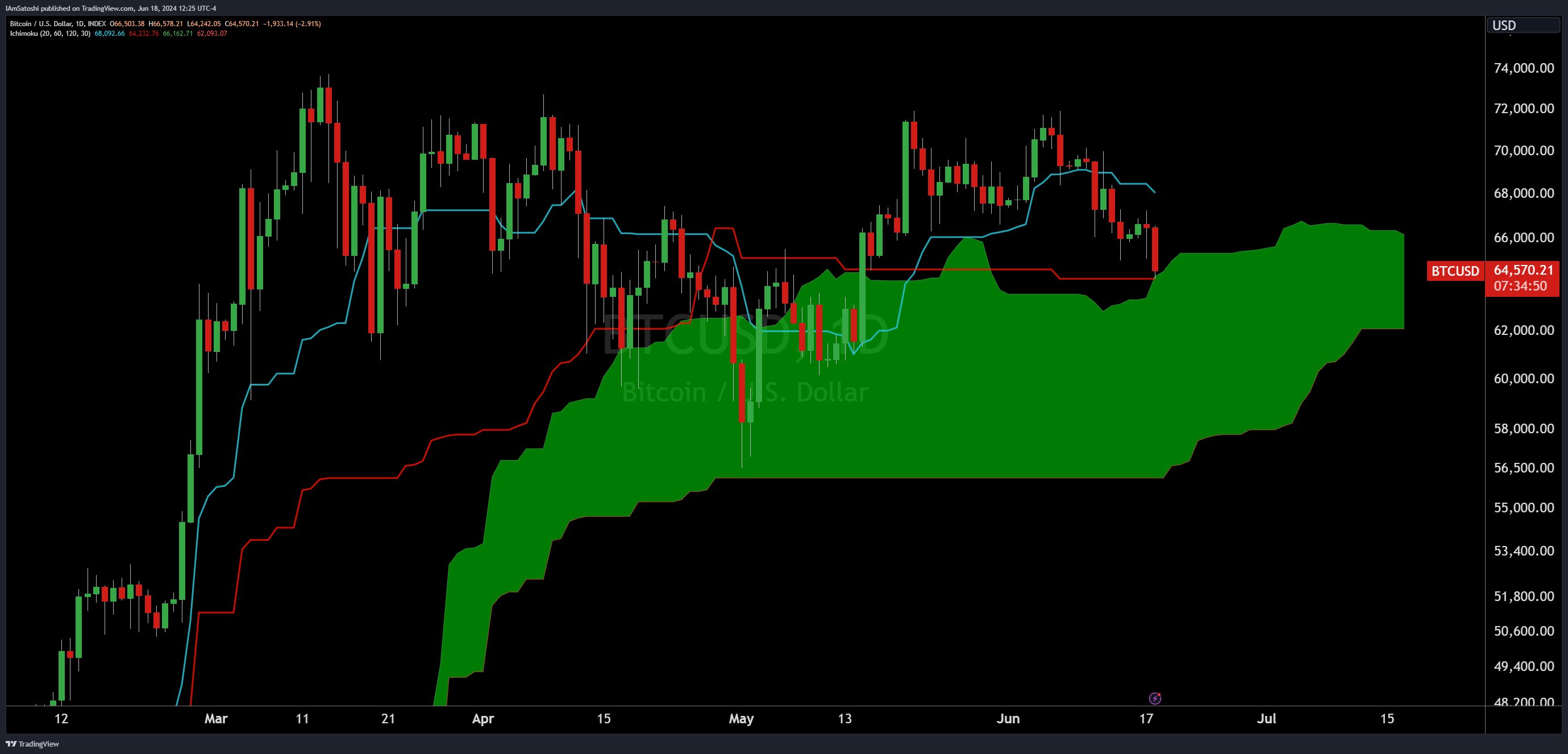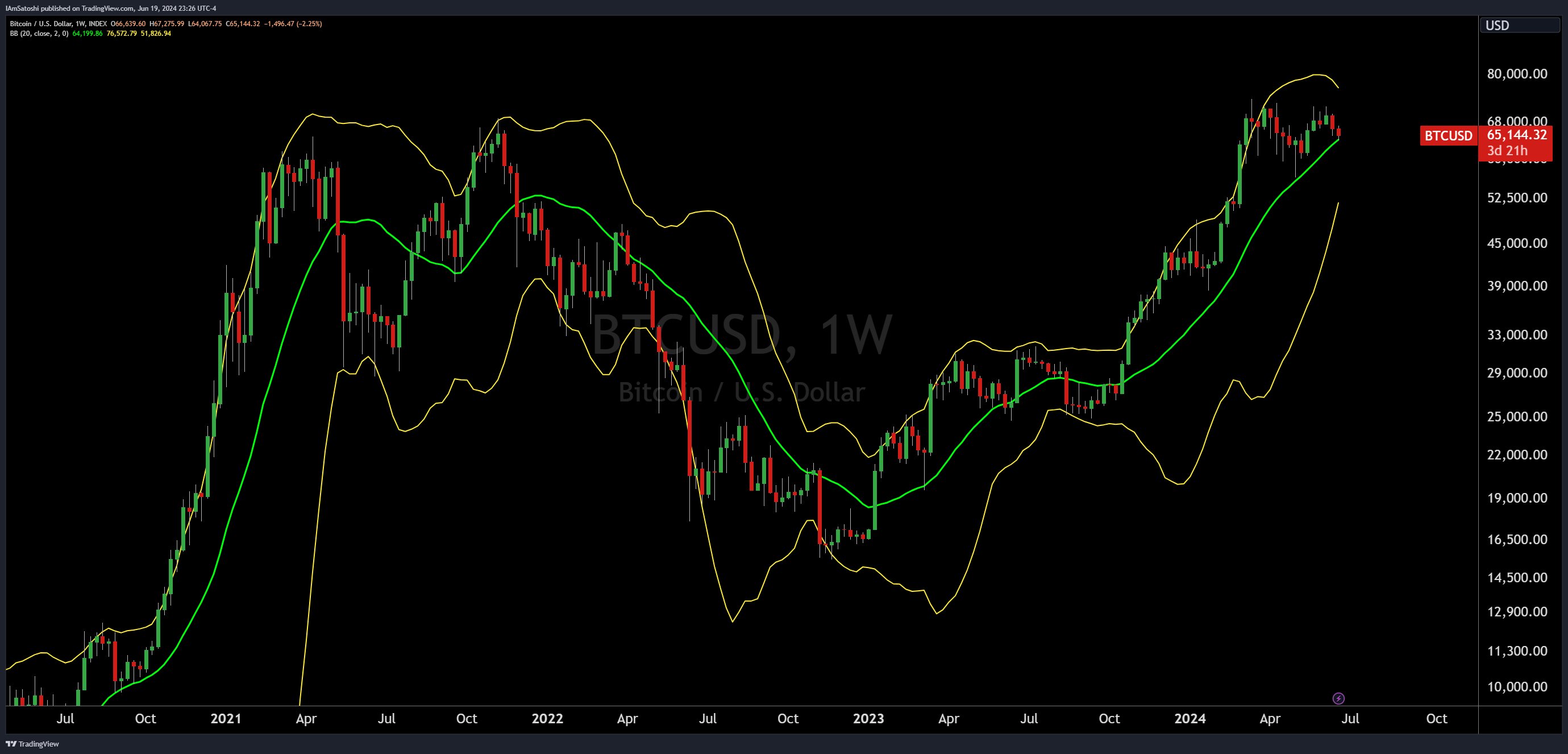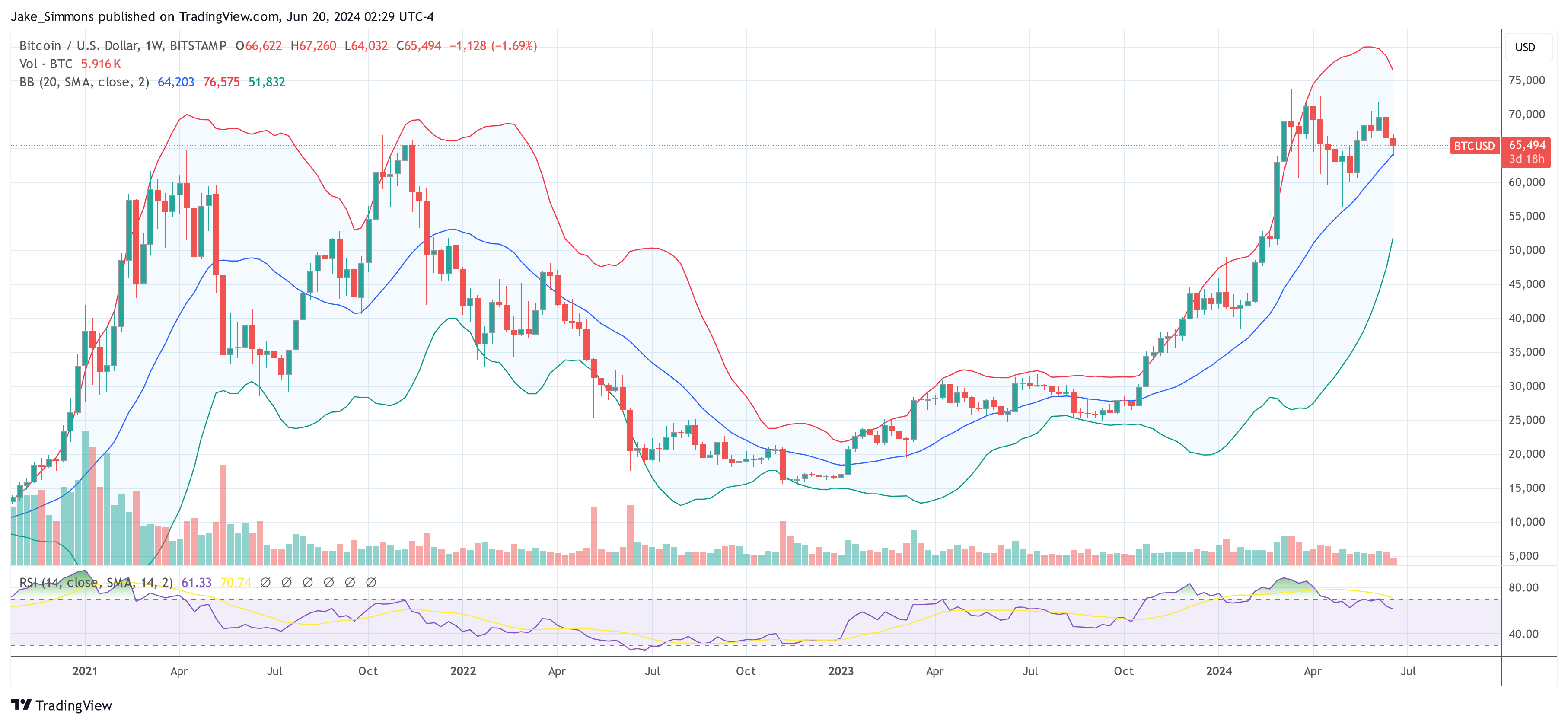Josh Olszewicz, a renowned crypto analyst, has recently shared critical insights into the immediate Bitcoin price future, employing two technical analysis frameworks: the Ichimoku Cloud and Bollinger Bands. These tools hint at pivotal moments that could shape the trajectory of the Bitcoin price in the near to medium term.
Bitcoin Analysis Using The Ichimoku Cloud
In the first chart featuring the daily Ichimoku Cloud, Olszewicz highlights a critical moment for Bitcoin as it navigates through this complex indicator. The Ichimoku Cloud, known for providing support and resistance levels as well as momentum and trend direction, shows Bitcoin trading near the edge of the cloud. This is significant because a break above the cloud could suggest a bullish outlook, while falling below the cloud often signals bearish momentum.

Here, Olszewicz emphasizes a ‘do or die’ scenario for Bitcoin. The price of Bitcoin, as recorded last on the chart at $64,570, approaches the edge of the cloud. “No one likes an ultimatum but it’s do or die here pretty soon on the daily BTC cloud,” warned.
Related Reading
A significant aspect of the Ichimoku Cloud chart is the relationship between the Tenkan-Sen (red line) and the Kijun-Sen (blue line). The Tenkan-Sen, which is a shorter-term moving average, remains above the Kijun-Sen, a longer-term moving average, indicating a positive momentum in the short run.
Bollinger Bands Weekly Analysis
Moving to the weekly chart equipped with Bollinger Bands, Olszewicz discusses another potential inflection point. Bollinger Bands serve as a measure of volatility—narrow bands suggest low volatility while wider bands indicate higher volatility. The Bitcoin chart shows a tightening of these bands around the current price level, which may precede a significant price movement, often referred to as a “Bollinger Band Squeeze.”

The fact that Bitcoin is hovering just above the midline (the 20-period moving average) of the Bollinger Bands at $64,238 points to a tenuous balance between buying and selling forces. However, the narrowing of the bands is particularly notable because it could lead to a decisive breakout or breakdown, depending on other market factors and trader sentiment.
If Bitcoin breaks below the midline, the next support could be found at the lower Bollinger Band, currently positioned around $51,792, which could represent a significant downturn in price. Conversely, should Bitcoin bounce off the midline and gain upward momentum, it might target the upper Bollinger Band, situated at approximately $76,684, indicating a potential rally.
Related Reading
The analyst points out that understanding the implications of a Bollinger Band Squeeze could be crucial for traders, as such periods of low volatility often end in sharp price moves. “If you didn’t like the Cloud ultimatum, here’s the weekly BBands,” remarked Olszewicz.
Both charts, though using different analytical tools, converge on a similar narrative: Bitcoin is at a potential turning point that could define its price action for the coming days or weeks. The current levels close to the upper boundaries of both the Ichimoku Cloud and the Bollinger Bands underscore the tension in the market.
At press time, BTC traded at $65,494.

Featured image created with DALL·E, chart from TradingView.com
Josh Olszewicz, a renowned crypto analyst, has recently shared critical insights into the immediate Bitcoin price future, employing two technical analysis frameworks: the Ichimoku Cloud and Bollinger Bands. These tools hint at pivotal moments that could shape the trajectory of the Bitcoin price in the near to medium term.
Bitcoin Analysis Using The Ichimoku Cloud
In the first chart featuring the daily Ichimoku Cloud, Olszewicz highlights a critical moment for Bitcoin as it navigates through this complex indicator. The Ichimoku Cloud, known for providing support and resistance levels as well as momentum and trend direction, shows Bitcoin trading near the edge of the cloud. This is significant because a break above the cloud could suggest a bullish outlook, while falling below the cloud often signals bearish momentum.

Here, Olszewicz emphasizes a ‘do or die’ scenario for Bitcoin. The price of Bitcoin, as recorded last on the chart at $64,570, approaches the edge of the cloud. “No one likes an ultimatum but it’s do or die here pretty soon on the daily BTC cloud,” warned.
Related Reading
A significant aspect of the Ichimoku Cloud chart is the relationship between the Tenkan-Sen (red line) and the Kijun-Sen (blue line). The Tenkan-Sen, which is a shorter-term moving average, remains above the Kijun-Sen, a longer-term moving average, indicating a positive momentum in the short run.
Bollinger Bands Weekly Analysis
Moving to the weekly chart equipped with Bollinger Bands, Olszewicz discusses another potential inflection point. Bollinger Bands serve as a measure of volatility—narrow bands suggest low volatility while wider bands indicate higher volatility. The Bitcoin chart shows a tightening of these bands around the current price level, which may precede a significant price movement, often referred to as a “Bollinger Band Squeeze.”

The fact that Bitcoin is hovering just above the midline (the 20-period moving average) of the Bollinger Bands at $64,238 points to a tenuous balance between buying and selling forces. However, the narrowing of the bands is particularly notable because it could lead to a decisive breakout or breakdown, depending on other market factors and trader sentiment.
If Bitcoin breaks below the midline, the next support could be found at the lower Bollinger Band, currently positioned around $51,792, which could represent a significant downturn in price. Conversely, should Bitcoin bounce off the midline and gain upward momentum, it might target the upper Bollinger Band, situated at approximately $76,684, indicating a potential rally.
Related Reading
The analyst points out that understanding the implications of a Bollinger Band Squeeze could be crucial for traders, as such periods of low volatility often end in sharp price moves. “If you didn’t like the Cloud ultimatum, here’s the weekly BBands,” remarked Olszewicz.
Both charts, though using different analytical tools, converge on a similar narrative: Bitcoin is at a potential turning point that could define its price action for the coming days or weeks. The current levels close to the upper boundaries of both the Ichimoku Cloud and the Bollinger Bands underscore the tension in the market.
At press time, BTC traded at $65,494.

Featured image created with DALL·E, chart from TradingView.com





















































































where buy clomiphene without prescription how to get clomid without prescription where can i buy generic clomiphene pill clomiphene medication uk how to get generic clomiphene tablets can i get generic clomid online can i buy clomiphene without prescription zei:
More content pieces like this would make the web better.
This is the kind of advise I recoup helpful.
buy azithromycin online cheap – order metronidazole pills how to get metronidazole without a prescription
rybelsus 14 mg canada – semaglutide usa buy generic periactin
domperidone without prescription – domperidone 10mg cost buy flexeril 15mg generic
inderal cheap – buy generic methotrexate order methotrexate 5mg
purchase amoxil pill – buy combivent no prescription buy cheap combivent
buy azithromycin pills – nebivolol 20mg usa bystolic 20mg sale
order nexium for sale – https://anexamate.com/ order nexium 20mg pills
coumadin online – anticoagulant buy cozaar 25mg
meloxicam 15mg cheap – mobo sin buy meloxicam 15mg sale
deltasone order online – https://apreplson.com/ prednisone 10mg generic
erectile dysfunction drug – fast ed to take site best pill for ed
buy fluconazole pills – fluconazole for sale online forcan tablet
purchase cenforce pill – https://cenforcers.com/# cenforce 50mg usa
cialis recreational use – does cialis make you harder cialis drug interactions
cialis purchase – https://strongtadafl.com/# free cialis samples
buy ranitidine 300mg pills – https://aranitidine.com/ order zantac 300mg online
online viagra – https://strongvpls.com/# sales@cheap-generic-viagra
This website absolutely has all of the bumf and facts I needed about this thesis and didn’t comprehend who to ask. sitio web
This is a theme which is in to my verve… Myriad thanks! Unerringly where can I notice the connection details due to the fact that questions? https://ursxdol.com/furosemide-diuretic/
This is the description of serenity I take advantage of reading. https://prohnrg.com/product/diltiazem-online/
I am in point of fact thrilled to glitter at this blog posts which consists of tons of worthwhile facts, thanks object of providing such data. https://ondactone.com/product/domperidone/
With thanks. Loads of conception!
https://doxycyclinege.com/pro/topiramate/
Thanks for sharing. It’s outstrip quality. https://sportavesti.ru/forums/users/ichnu-2/
buy forxiga 10mg online cheap – this forxiga 10 mg pills
purchase orlistat pills – https://asacostat.com/# xenical 60mg pills